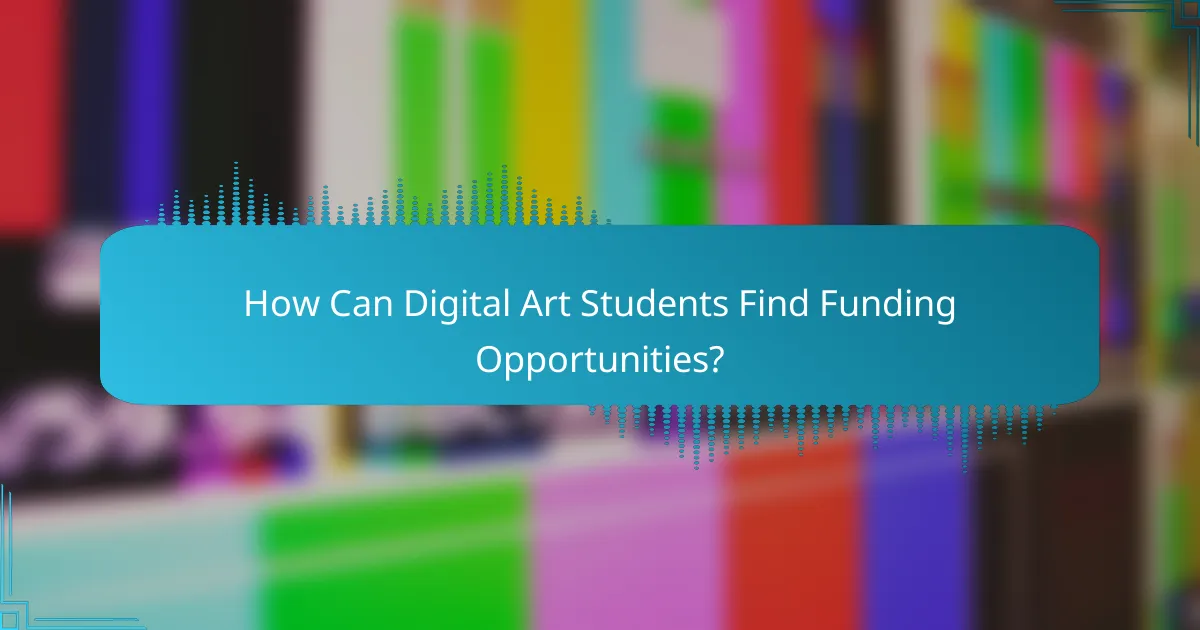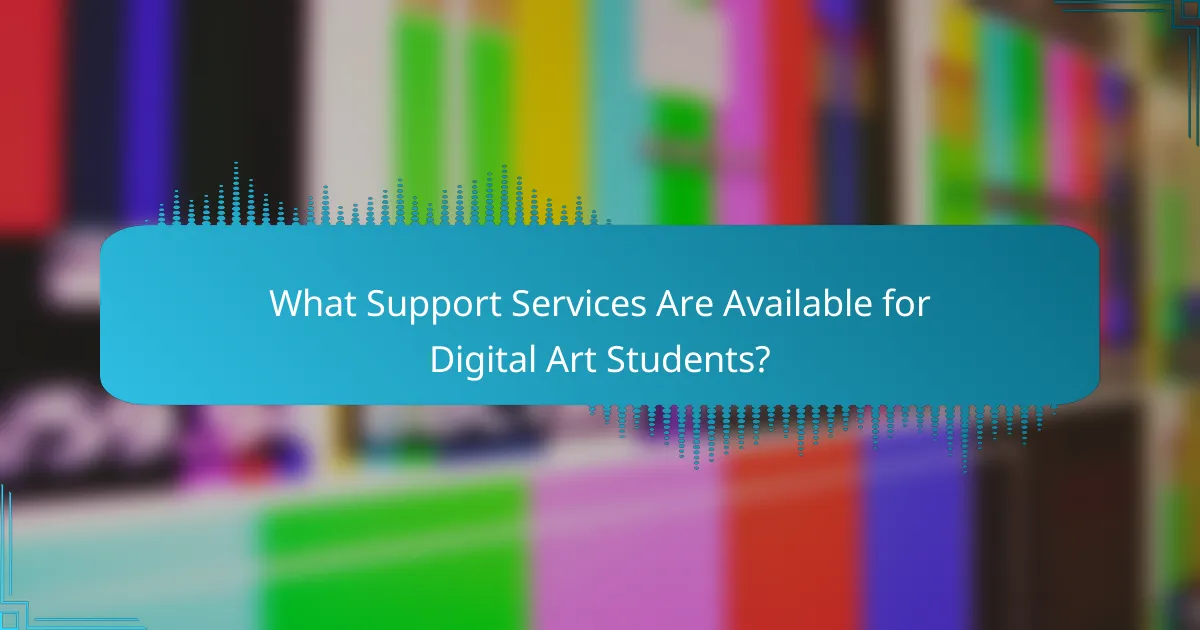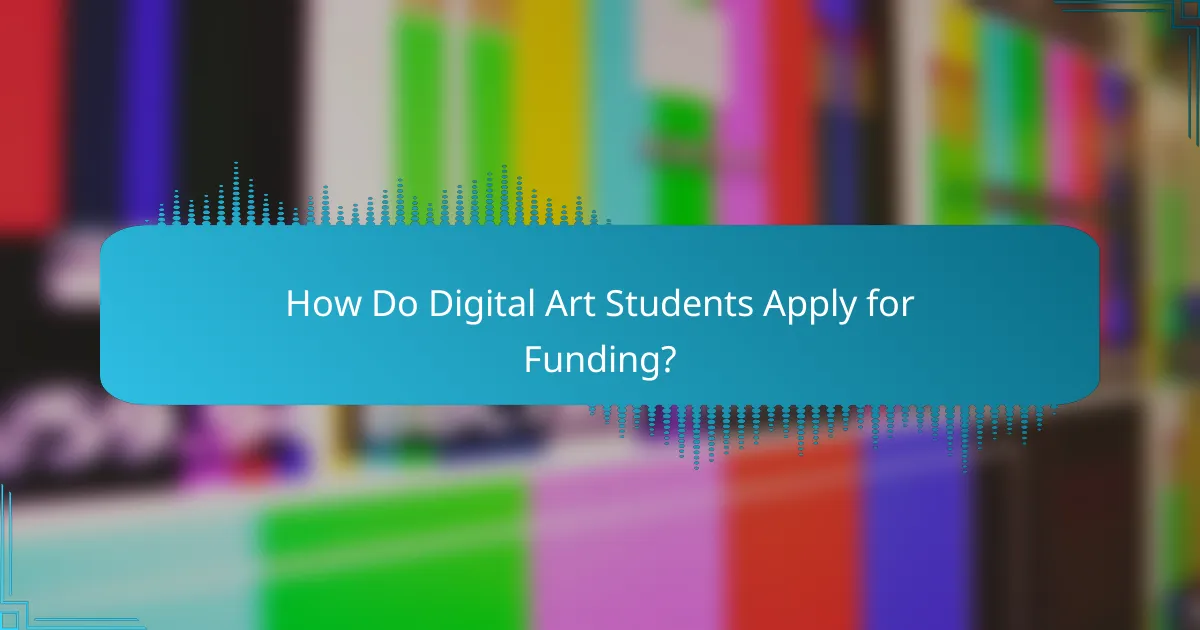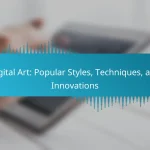Digital art students have access to a range of scholarships and funding opportunities that can significantly alleviate the financial burden of their education. By exploring online scholarship databases, university financial aid offices, and art competitions, students can find resources tailored to their specific skills and backgrounds. Additionally, support services such as mentorship programs and workshops are available to enhance their educational experience and professional growth.

What Scholarships Are Available for Digital Art Students?
Digital art students can access various scholarships and funding opportunities to support their education. These scholarships often target specific skills, backgrounds, or projects, making it essential to research and apply for those that align with individual goals.
National Art Education Association Scholarships
The National Art Education Association (NAEA) offers scholarships to students pursuing degrees in art education. These scholarships typically range from a few hundred to several thousand dollars, depending on the applicant’s qualifications and the specific program.
To apply, students must demonstrate a commitment to art education through their academic achievements, portfolio submissions, and letters of recommendation. It’s advisable to check the NAEA website for application deadlines and eligibility criteria.
Adobe Creative Residency
The Adobe Creative Residency program provides funding and support for emerging artists, including digital art students. Selected residents receive a stipend, access to Adobe tools, and mentorship opportunities to help develop their creative projects over a year.
Applicants should present a compelling project proposal that showcases their artistic vision and how they plan to utilize Adobe software. This residency not only offers financial support but also invaluable exposure within the creative community.
Art Institute Scholarships
Many art institutes and colleges offer scholarships specifically for digital art students. These scholarships can cover tuition fees, materials, and other educational expenses, often ranging from a few thousand to tens of thousands of dollars.
Students should research individual institutions for specific scholarship offerings and application processes. It’s common for these scholarships to require a portfolio submission and an essay detailing the student’s artistic journey and future aspirations.
Local Community Grants
Local community organizations often provide grants to support artists and students in the arts. These grants can vary widely in amount and eligibility requirements, typically focusing on projects that benefit the community or promote local culture.
Students should explore opportunities through local arts councils, community foundations, and non-profits. Engaging with these organizations can also lead to networking opportunities and additional funding sources.
State-Specific Funding Programs
Many states have specific funding programs designed to support students in the arts, including digital art. These programs may offer scholarships, grants, or loans, often tailored to residents pursuing education in their home state.
Students should visit their state’s arts commission website to find relevant funding opportunities. It’s important to pay attention to application deadlines and specific eligibility criteria, as these can vary significantly from one state to another.

How Can Digital Art Students Find Funding Opportunities?
Digital art students can find funding opportunities through various channels, including online scholarship databases, university financial aid offices, and art competitions. Each of these resources offers unique advantages and can significantly ease the financial burden of education.
Online Scholarship Databases
Online scholarship databases compile a wide range of funding opportunities specifically for students in digital art and related fields. Websites like Fastweb, Cappex, and College Board allow students to search for scholarships based on their skills, interests, and demographics.
When using these databases, ensure your profile is complete and up-to-date to receive tailored scholarship matches. Regularly check for new listings, as opportunities can change frequently.
University Financial Aid Offices
University financial aid offices are valuable resources for digital art students seeking funding. These offices can provide information on institutional scholarships, grants, and work-study programs that may not be widely advertised.
Students should schedule meetings with financial aid advisors to discuss their specific needs and explore all available options. Be proactive in applying for aid early, as some funding sources have limited availability.
Art Competitions and Grants
Participating in art competitions and applying for grants can provide not only funding but also exposure and recognition. Many organizations, both local and national, offer competitions specifically for digital artists, often with cash prizes or scholarships as rewards.
Research competitions that align with your artistic style and ensure you meet all eligibility requirements. Keep track of deadlines and submission guidelines to maximize your chances of success.

What Support Services Are Available for Digital Art Students?
Digital art students can access a variety of support services designed to enhance their educational experience and professional development. These services include mentorship programs, online communities, and workshops that focus on skill development.
Mentorship Programs
Mentorship programs connect digital art students with experienced professionals in the field. These relationships can provide invaluable guidance, feedback, and networking opportunities that may not be available through traditional classroom settings.
Students should look for programs offered by universities, art organizations, or online platforms. Many mentorships are structured to include regular meetings, project reviews, and career advice, which can significantly boost a student’s confidence and skills.
Online Communities and Forums
Online communities and forums serve as platforms for digital art students to share their work, seek feedback, and collaborate with peers. These spaces often host discussions on techniques, tools, and industry trends, fostering a sense of belonging and support.
Popular platforms include DeviantArt, ArtStation, and Reddit groups focused on digital art. Engaging actively in these communities can help students build a portfolio, gain exposure, and connect with potential collaborators or employers.
Workshops and Skill Development
Workshops are essential for digital art students to refine their skills and learn new techniques. Many institutions and online platforms offer workshops that cover various topics, from software tutorials to specific art styles.
Students should seek workshops that align with their interests and career goals. Participating in these hands-on sessions can lead to practical experience and enhance a student’s portfolio, making them more competitive in the job market.

What Are the Eligibility Criteria for Scholarships?
Eligibility criteria for scholarships in digital art typically include academic performance, portfolio submissions, and demonstrated financial need. Understanding these requirements can help students prepare effectively and increase their chances of securing funding.
Academic Performance Requirements
Many scholarships require a minimum GPA, often around 2.5 to 3.5, depending on the institution and the competitiveness of the program. Some scholarships may also consider standardized test scores, such as the SAT or ACT, especially for undergraduate programs.
Students should maintain strong academic records in relevant subjects, such as art, design, and technology, as these may be weighted more heavily in the evaluation process. Regularly checking with scholarship providers for specific academic criteria is advisable.
Portfolio Submission Guidelines
A well-curated portfolio is often a critical component of scholarship applications for digital art students. Most programs require a selection of original works that showcase creativity, technical skills, and personal style, typically ranging from 10 to 20 pieces.
Students should pay attention to submission guidelines, including format, file size, and presentation requirements. Including a variety of work, such as digital illustrations, animations, or graphic designs, can demonstrate versatility and depth in artistic abilities.
Demonstrated Financial Need
Many scholarships assess financial need through documentation, such as the Free Application for Federal Student Aid (FAFSA) in the U.S. or equivalent forms in other countries. Applicants may need to provide income statements or tax returns to support their claims.
Students should be prepared to explain their financial situation clearly and concisely. Highlighting any extenuating circumstances, such as family obligations or unexpected expenses, can strengthen their case for need-based scholarships.

How Do Digital Art Students Apply for Funding?
Digital art students can apply for funding through various scholarships, grants, and financial aid options tailored to their field. The application process typically involves submitting a portfolio, academic records, and personal statements to demonstrate their artistic skills and financial need.
Application Process Overview
The application process for funding usually starts with researching available scholarships and grants specific to digital art. Students should carefully review eligibility criteria, deadlines, and required documentation for each opportunity. Many institutions and organizations provide detailed guidelines on their websites.
Once students identify suitable funding options, they should prepare their application materials. This often includes a portfolio showcasing their best work, letters of recommendation, and a personal statement outlining their passion for digital art and career aspirations. It’s crucial to tailor each application to highlight how the funding will support their educational goals.
After submitting applications, students should follow up to confirm receipt and inquire about the timeline for decisions. Keeping track of multiple applications can be challenging, so creating a checklist with deadlines and requirements can help manage the process effectively.


